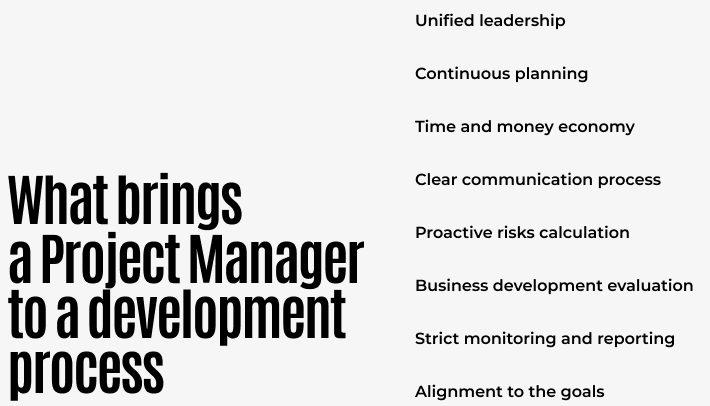One day we received the inquiry for the development of a CRM system for a gym network. The owner willing to save some funds for further active marketing campaigns requested to start the project without a Project Manager. Luckily for him, we made the necessary amount of valid arguments to change this decision. So with this article, we wish to share our experience and describe the positive qualities achieved from the PM leading the project.
What brings a Project Manager to a development process
No doubt that the wish to save funds is a crucial goal of any business. Though in a situation with the PM, such an economy can become a pit. Often it appears due to misunderstanding of the functions each PM should perform in the project and their importance.
Unified leadership
The primary task of any manager is to lead the team and define the course of the activities they take. The PM defines the goals, monitors the current state of the tasks performing, and makes allowances in the project flow. When there is no such a person, some prominent signals of any deviations can be omitted and not properly reacted.
Continuous planning
Leadership task defines the next prominent feature of a manager – planning. In case one person starts to lead the project from the very beginning, they have the opportunity to define the integral plan of all activities needed in the course of development. They build the sequence of the tasks to be performed, as well as the necessary resources. Anyway, the planning should not end with the development start. PM analyses the current situation on a project, reacts to some deviations, and brings rectifications.
Time and money economy
When having strict planning, it is possible to outline the exact amount of money needed for the development process. The absence of a PM leads to the situation when each department, participated in the development, calculates its expenses without considering the others. The manager, on the contrary, grasps the entire picture and can redirect the assets to the areas of concern. And the situation would not run to over budgeting or time loss.
Clear communication process
Communication with one person simplifies the process of task delivery and processing. At first glance, the creation of one more step in the communication ladder can seem superfluous. Though, with a team of three persons, an owner has to communicate with them all about their tasks and responsibilities. That mainly means that one person has to accustom themself to each member of the team and their communicational preferences. PM deprives of such a variety and serves as the only person who adjusts themselves to your requirements. The entire flow of communication streams through one person who definitely knows what was informed about and what is not.
Proactive risks calculation
Advanced planning enables the calculation of risks before any problem appears. Such an evaluation takes place before the actual project start. That ensures leaving some spare resources and intending possible actions that should be taken in any emergencies. On the contrary, reactive measures can only serve as mitigations of negative consequences. Usually, such results cause some losses anyway. Proactive planning serves as one of the key elements of keeping high quality and applicability of the final product.
Business development evaluation
By applying the experience of the previous projects, the PM can calculate the possible directions for further business development. This evaluation is based on the business goals of the intended product as well. With this in mind, a PM can make suggestions on what functions, features or elements will be introduced to the product. That ensures the final product strictly cohere with the prior business goals. As well as leaves the directions for further development opportunities.
Strict monitoring and reporting
PM constantly controls the entire process from the start to the final deployment and launch. As far as the milestones of the project are defined, it is much easier to control deadlines for a business. The development process is tracked according to specific tasks and reported on daily, weekly meetings, or in the course of sprint accomplishment presentations. With the PM on a project, the development schedule receives realistic periods. This person knows the current situation of the project flow and can predict the time needed for the completion of the task.
Alignment to the goals
The person who carries the entire project is personally interested in its success. In such a case, the PM will take all pains to deliver the best quality of the final code and implement the core features. These two elements define the satisfaction of the primary business goals that were stated at the project start. As well as a considerably high ROI after the project completion.

The general steps PMs take in the course of development
The development process varies in different companies. Though, it is possible to outline the general steps taken by the PMs in the development flow. This list can be used to define whether your project is completely controlled or not.
- Before the project start, the initial planning of the resources according to the project technology takes place. The project team, together with the PM and client, concludes the estimate and statement of works. They define the basic business goals and product features.
- Comprehensive planning of the sprints is performed by the PM to calculate and state the deadlines and separate the project into modules. Later such segregation will allow performing intermediary testings for serviceability.
- Depending on the management methodology, the PM can perform daily meetings with the team. That helps to keep themselves informed about the current project’s state.
- Weekly plannings allow evaluation of the positive and negative achievements of the last week. After such a meeting, the PM can introduce some changes, make suggestions, and plan rectifications for the next week.
- Collective evaluation of the performed works is done at the end of each block of the project or sprint. This presentation outlines the milestones taken and defines the steps needed for further development.
- After the successful final project testing and its deployment, the PM collects the feedback about the project and product. This feedback is taken not only from the business owner but also from the team of developers.
- The team performs a retrospective review to find if the project was developed according to the deadlines and resource limits. The general evaluation can be performed to calculate possible improvements or additional features.
The skills and features, the effective PM should acquire
Though the effectiveness of staff not always can be measured in some commonly accepted figures, some features can outline a good PM.
When a PM applies specialized project management services, that gives better control over the project state. Additionally, special services make communication easier and faster. A good PM can recommend leading the project in the system they are more aware of. But in any case, the final decision about what instruments to use is after the owner.

The second skill of a good PM – is the ability to adjust to the needs of the client. Any business cooperation is a mutual process, but when it comes to communication with the customer, it is necessary to live in the client’s world. Understanding of cultural and national peculiarities or prominent features gives better comprehension of the product and business.
A project manager is not a compulsory part of a team of developers, but they bring too many positive features to the development process. Without PM, building a product can become unpredicted and overwhelming for a business. Planning, clearness in communication, better management, and control – these are the core issues a good manager can bring to the development flow. The comfort and certainty over the outcome cost more than the additional member of the development team.
Contact us to feel the power of such a communication with the dedicated manager in the course of product development.


















